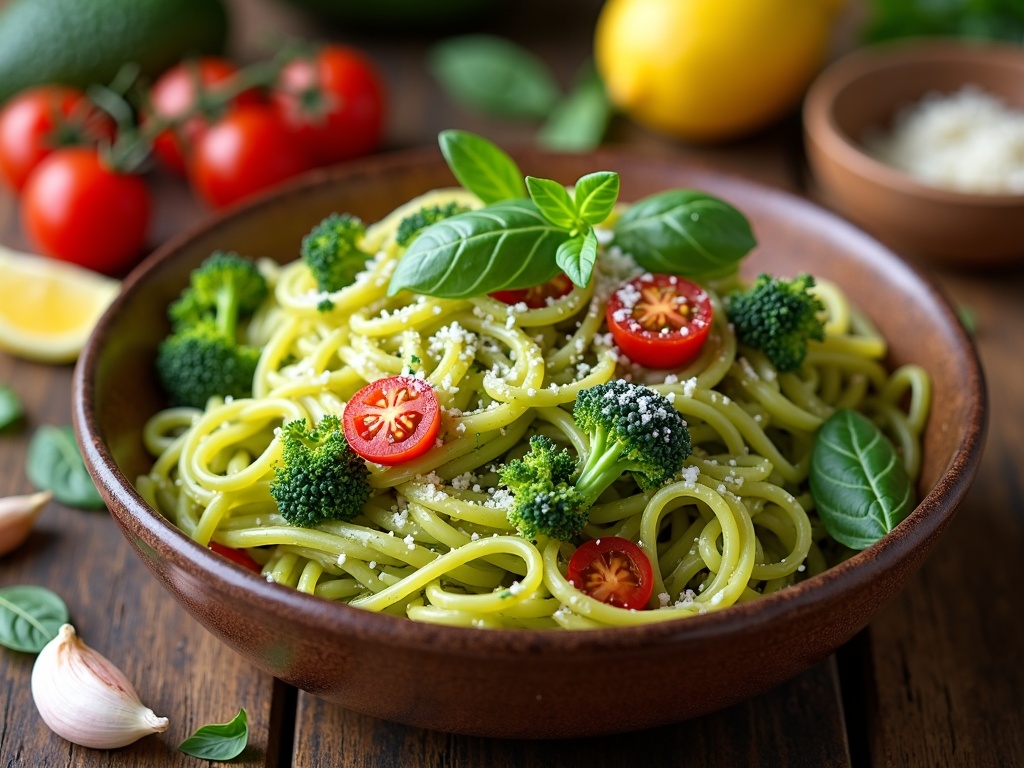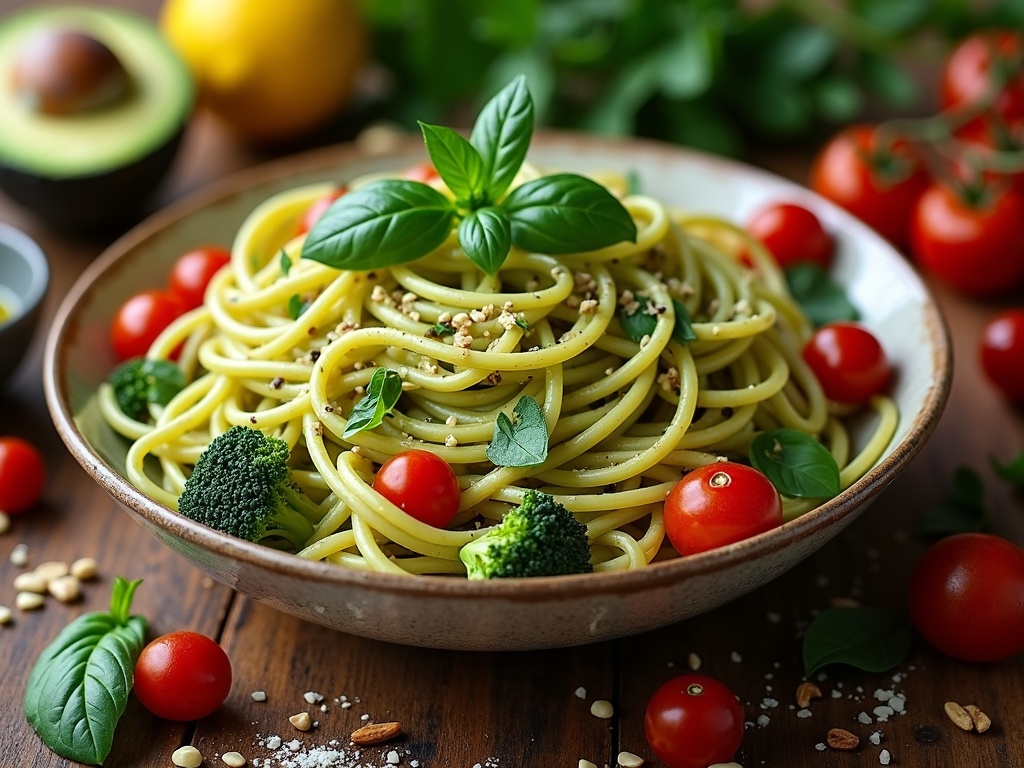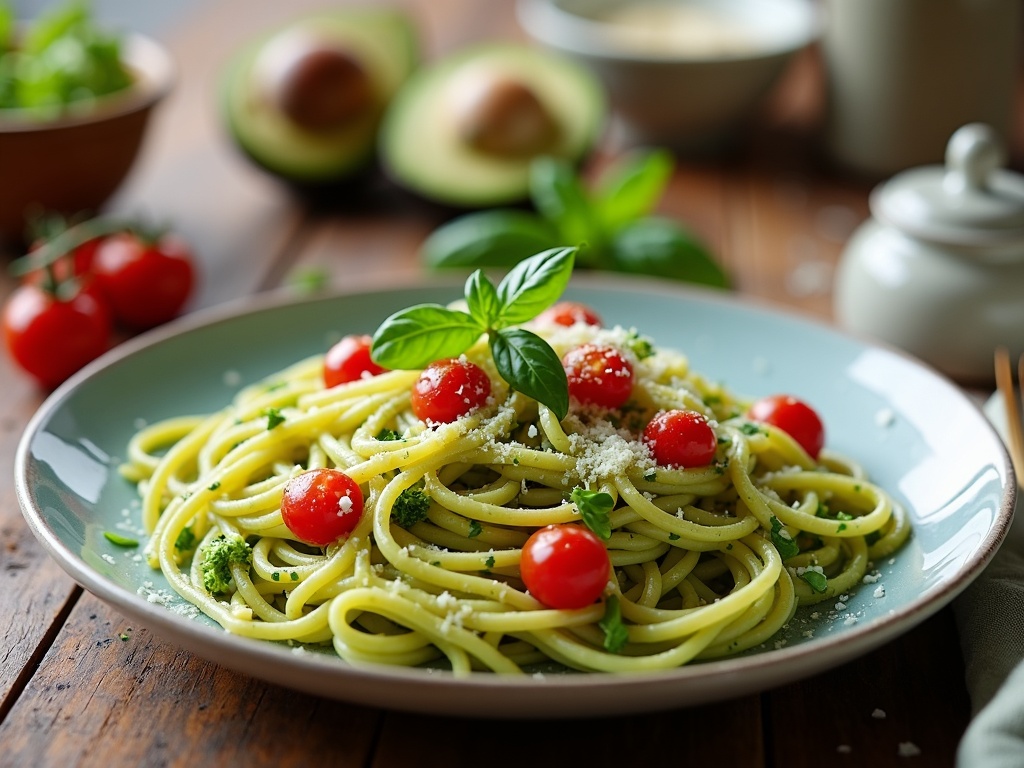Avocado pasta stands out as a delightful alternative to traditional pasta dishes, turning this nutrient-dense fruit into a creamy sauce that delivers both comfort and health benefits. This dish combines the satisfying richness of classic pasta sauces with impressive nutritional value, including heart-healthy fats, fiber, and essential vitamins that boost overall wellbeing.
Find In This Article
Key Takeaways
- Avocado pasta provides approximately 300 calories per serving with 15 grams of beneficial monounsaturated fats that can help improve cholesterol levels.
- The dish delivers an impressive nutritional profile with 9 grams of fiber per serving, which helps maintain fullness longer and supports digestive health.
- Rich in vitamins E, C, K, and B-complex vitamins, avocado pasta offers antioxidant protection and supports immune function, skin health, and energy production.
- The natural creaminess eliminates the need for heavy cream or cheese, reducing saturated fat while maintaining the satisfying texture of comfort food.
- Avocado pasta is highly adaptable for various dietary needs, including vegetarian, vegan, and gluten-free options, making it accessible for different health preferences.
Why Avocado Pasta is the New Healthy Comfort Food
Avocado pasta has surged in popularity among health enthusiasts seeking satisfying meals without compromising nutritional value. This delightful dish transforms the humble avocado into a luscious sauce that coats pasta perfectly, creating a meal that feels indulgent while delivering impressive health benefits.
I’ve noticed more people turning to avocado pasta as their go-to weeknight meal, much like traditional creamy pasta dishes but with a nutritional upgrade. The creamy texture rivals dairy-based sauces while keeping the dish suitable for plant-based diets.
Nutritional Powerhouse in a Bowl
The nutritional profile of avocado pasta makes it truly stand out in the comfort food category. Each avocado contributes approximately 15 grams of beneficial monounsaturated fats—the heart-healthy kind that can help improve cholesterol levels. A typical serving of avocado pasta provides around 300 calories, making it substantial enough for a main dish while remaining reasonable for those watching their intake.
What’s particularly impressive is the balance of nutrients: 3 grams of protein, 12 grams of carbohydrates, and a whopping 9 grams of fiber per serving. This fiber content helps keep you feeling full longer, making it easier to maintain healthy eating habits throughout the day.
Avocados also pack a significant vitamin punch, containing high amounts of:
- Vitamin E: A powerful antioxidant that supports skin health
- Vitamin C: Essential for immune function and collagen production
- Vitamin K: Important for proper blood clotting and bone health
- B-complex vitamins: Crucial for energy production and nerve function
I find that avocado pasta fits perfectly into various dietary approaches. It’s especially appealing to those reducing animal products without sacrificing creamy textures in their meals. The versatility also allows for easy modifications—add chicken for extra protein or broccoli for additional nutrients.
The simplicity of preparing avocado pasta adds to its appeal. Simply blend ripe avocados with garlic, lemon juice, olive oil, and seasonings to create a sauce that rivals traditional white sauce pasta in creaminess but surpasses it nutritionally. The natural creaminess eliminates the need for heavy cream or large amounts of cheese, cutting down on saturated fat while maintaining that comfort food feeling.
The adaptability of avocado pasta makes it suitable for various dietary needs. It’s naturally vegetarian and can easily be made vegan by omitting cheese garnishes. Those following gluten-free diets can simply swap in their favorite gluten-free pasta.
For busy households, this dish offers convenience without sacrificing quality. The sauce comes together in minutes while the pasta cooks, and leftovers (if properly stored with a bit of lemon juice to prevent browning) make for quick lunches the next day.
As we continue seeking balance between enjoyable eating and nutritious choices, avocado pasta represents the perfect middle ground. It satisfies cravings for rich, comforting pasta while delivering substantial nutritional benefits—proving that healthy comfort food isn’t an oxymoron but a delicious reality.

The Nutritional Powerhouse Behind the Dish
Avocado pasta isn’t just delicious—it’s a nutritional game-changer compared to traditional pasta dishes. The creamy, rich texture of avocados creates a perfect sauce base while delivering impressive health benefits that many conventional pasta sauces simply can’t match.
Heart-Healthy Fats That Satisfy
Avocados contain predominantly monounsaturated fats, which are vastly different from the saturated fats found in cream-based pasta sauces. While traditional alfredo or white sauce pasta can contain up to 20 grams of saturated fat per serving, avocado-based sauces provide heart-healthy alternatives without sacrificing creaminess.
Monounsaturated fats actually help improve cholesterol levels by increasing HDL (the “good” cholesterol) while reducing LDL (the “bad” cholesterol). This makes avocado pasta an excellent choice for maintaining cardiovascular health. These healthy fats also help you feel fuller longer, which can prevent overeating later in the day.
The fat content in avocados serves another important purpose—it helps your body absorb fat-soluble vitamins like A, D, E, and K from other ingredients in your pasta dish. When I add vegetables like broccoli to pasta, the avocado helps maximize the nutritional benefits.
Avocados also contain nearly 20 different vitamins and minerals, including potassium (more than bananas!), vitamin K, vitamin E, vitamin C, and several B vitamins. This nutrient density transforms a simple creamy pasta dish into a nutritional powerhouse.
Fiber and Plant-Based Benefits
One of the most overlooked advantages of avocado pasta is its fiber content. A typical serving contains nearly double the fiber of regular pasta dishes, supporting digestive health and helping maintain steady blood sugar levels. This makes it particularly valuable for those watching their glycemic response.
For those following plant-based or vegetarian diets, avocado pasta offers several key benefits:
- Complete protein potential when paired with legumes or whole grain pasta
- Natural creaminess without dairy products
- Higher nutrient density than many vegan pasta alternatives
- Versatility for adding other plant-based ingredients like nuts or pesto variations
The plant compounds in avocados, including phytosterols and polyphenolic compounds, provide antioxidant protection that goes beyond basic nutrition. These compounds help fight oxidative stress and inflammation in the body, potentially benefiting everything from skin health to cellular aging.
The carotenoids lutein and zeaxanthin found in avocados are particularly noteworthy for eye health, while the vitamin E content supports skin elasticity and appearance. I’ve noticed improved skin texture since incorporating more avocado-based dishes into my diet.
Beyond the immediate health benefits, avocado pasta represents a sustainable approach to satisfying meals. The substantial nature of the dish means you’ll likely eat less overall while feeling more satisfied—a win for both your health and grocery budget.
For those concerned about calorie content, it’s worth noting that while avocados are calorie-dense, their nutrient density and satiating properties often lead to consuming fewer calories overall throughout the day. The quality of calories matters just as much as the quantity.
By substituting traditional dairy-based sauces with avocado, you’re not just making a lateral move—you’re significantly upgrading the nutritional profile of your pasta dish while maintaining the comfort food experience we all crave.

Create Restaurant-Quality Avocado Pasta at Home
I’ve mastered making avocado pasta that rivals fancy Italian restaurants, and you can too with this simple recipe. The creamy texture of avocados creates a luscious sauce without heavy cream, making this dish both indulgent and nutritious.
Essential Ingredients and Preparation
To create this delicious creamy pasta dish, you’ll need:
- 2 ripe avocados (peeled and pitted)
- 2 garlic cloves (minced)
- Juice of 1 lemon
- 12 ounces pasta (spaghetti or linguine work best)
- Salt and pepper to taste
Finding perfectly ripe avocados is crucial for this recipe. Look for avocados that yield slightly to gentle pressure – not too firm and not too mushy. The skin should be dark but not shriveled. I often buy avocados a few days before cooking and let them ripen on my counter.
While traditional pasta works wonderfully, don’t hesitate to experiment with alternatives. Whole-grain pasta adds a nutty flavor and extra fiber, while chickpea pasta boosts the protein content significantly. These alternatives pair surprisingly well with the creamy avocado sauce.
For the cooking process, boil your pasta according to package instructions until al dente. Meanwhile, blend the avocados, garlic, lemon juice, salt, and pepper until smooth. When the pasta is ready, drain it (saving a little pasta water) and toss it with the avocado mixture. If the sauce seems too thick, add a splash of the reserved pasta water.
The versatility of this dish truly shines with toppings. Cherry tomatoes add a burst of acidity, fresh basil brings aromatic notes, and red pepper flakes provide a gentle heat. For extra richness, a sprinkle of parmesan cheese takes this broccoli pasta variation to new heights when you add some blanched broccoli florets.
For a protein boost, consider adding grilled chicken to create a satisfying pesto chicken pasta hybrid. The avocado sauce pairs beautifully with the savory chicken flavors.
This avocado pasta also makes an excellent base for a white sauce pasta recipe alternative that’s lighter yet equally satisfying. The natural creaminess eliminates the need for heavy cream or butter while delivering that luxurious mouthfeel we all crave.
How It Stacks Up Against Traditional Pasta
When comparing avocado pasta to traditional options, the nutritional differences are quite striking. A typical serving of avocado pasta contains approximately 300 calories and is packed with healthy monounsaturated fats that support heart health. I’ve found that making the switch to creamy pasta with avocado instead of dairy can make a significant impact on my daily calorie intake without sacrificing flavor.
In contrast, traditional Alfredo sauce pasta typically weighs in at around 400 calories per serving with a hefty 35g of fat—much of it saturated. That’s a 100-calorie difference per plate, which adds up quickly if pasta is a regular part of your meal rotation.
Nutritional Benefits Beyond Calories
The benefits of avocado pasta extend well beyond just calorie counts:
- Higher fiber content compared to marinara sauce, promoting longer-lasting fullness
- Rich in potassium, which helps balance sodium levels and supports healthy blood pressure
- Contains vitamin E and antioxidants that protect cells from damage
- Provides heart-healthy monounsaturated fats instead of saturated fats found in cream-based sauces
- Naturally dairy-free, making it suitable for those with lactose intolerance
What’s particularly impressive is how avocado pasta maintains that satisfying creamy texture we crave from dishes like white sauce pasta while significantly reducing the calorie load. The natural creaminess of avocados creates a luxurious mouthfeel that tricks your brain into thinking you’re indulging in something much more decadent.
The digestive health benefits shouldn’t be overlooked either. The fiber content in avocados supports gut health and promotes regular digestion. I’ve noticed that after switching to broccoli pasta with avocado sauce, I feel lighter and less bloated compared to when I eat traditional cream-based pasta dishes.
Another advantage is versatility. Just as with pesto chicken pasta, avocado pasta works wonderfully with protein additions like grilled chicken, shrimp, or plant-based alternatives. This makes it easy to create a balanced meal that provides sustained energy.
For those monitoring cholesterol levels, avocado pasta offers a clear advantage. The absence of heavy cream and butter—staples in traditional Alfredo sauce—means you’re avoiding dietary cholesterol while still enjoying a rich, satisfying pasta experience.
The subtle flavor profile of avocado also serves as an excellent canvas for herbs and seasonings, allowing for endless customization. I find that adding fresh basil, a touch of lemon zest, and a small amount of nutritional yeast creates a flavor complexity that rivals even the most decadent traditional pasta sauces.
Texture-wise, avocado pasta sauce clings beautifully to pasta shapes with ridges or hollows, such as fusilli, penne, or orecchiette. This ensures every bite delivers the perfect amount of creamy goodness, something that thinner marinara sauces sometimes fail to achieve.
For meal prep enthusiasts, avocado pasta does require a bit more planning since the sauce is best enjoyed fresh to prevent oxidation. However, adding a splash of lemon juice helps maintain its vibrant green color and fresh taste for a day or two in the refrigerator.
Sources:
Harvard Health Publishing, Centers for Disease Control and Prevention (CDC), Healthline, EatingWell Magazine

